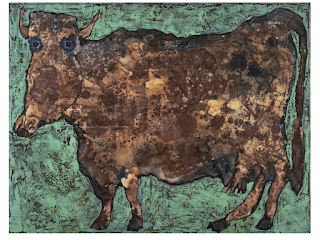Two Museum Visits—and an Art Gallery Not Visited
***
Stepping off the elevator at the Museum of Modern Art several years ago, I proceeded into a room of paintings that I was sure that I had visited many times before. However, this time as I turned to the wall on my right, I was stopped in my tracks by a painting that I had no recollection of seeing previously: “The Cow with the Subtile Nose” by Jean Dubuffet: ***
Some years later, wandering the Upper East Side of Manhattan, I decided to drop in at the International Center of Photography, then located on museum row on upper Fifth Avenue. The ICP was hosting a group exhibition, each of the participating photographers being allotted wall space for both his prints and a statement of purpose. As I walked around the gallery I became aware of one salient fact—the photographers whose pictures held my attention had all declined to make a statement about their work. Their photographs worked as photographs because their images contained all the information needed. In contrast, there was one photographer who had an IDEA: he was in Hawaii and decided to go out into the tropical forest in the middle of the night and snap pictures at one location facing in different directions. The result was a set of images that looked like nothing at all, and had no compositional sense or internal tension.
***
The art gallery not visited was in Suffolk, England.
As reported by the Daily Telegraph in 2001 (link: http://www.telegraph.co.uk/news/uknews/1312686/Student-lazes-in-bed-for-her-art.html), for her end-of-the-year project an art student named Katherine Hymers was to spend four days lying asleep on a single bed set in the middle of the gallery amid the work of her fellow students. Her “work,” she said, was “a symbol of her struggle as an artist, representing the way that her art has become her life.”
Of course, just by looking at someone snoozing, one would instantaneously grasp that meaning, right? Or would one have to poke Ms Hymers in the ribs and ask, “What the hell are you up to?”
***
Francis Bacon (the 20th Century painter, not Shakespeare’s contemporary of the same name) once said, “If you can talk about it, why paint it?” Words are no substitute for (and certainly not an improvement on) the direct experience of art. Critic Jonathan Jones recently stated in the Guardian, “Art doesn't have to be about anything to be good. In fact, the easier it is to say what a work is about, the less interesting that work becomes.” I am reminded of the second- and third-rate books in the syllabi of some of my former colleagues; they were there because they were easy to teach in a connect-the-dots way. One could talk about Themes and Ideas all day. Never mind that the works were in themselves “weary, stale, flat and unprofitable,” to quote Hamlet.
Henri Cartier-Bresson said great photography depicted "the decisive moment,” which he described as “the simultaneous recognition, in a fraction of a second, of the significance of an event as well as the precise organization of forms which gives that event its proper expression." Perhaps all great art, each in a way appropriate to its particular genre, strives to accomplish the same result.
-----------------------------------------------------------------------------
To view some paintings by Francis Bacon: http://www.ibiblio.org/wm/paint/auth/bacon/
To view some photographs by Cartier-Bresson: http://images.google.com/images?hl=en&rlz=1B2RNFA_enUS304US342&q=henri+cartier-bresson+the+decisive+moment&um=1&ie=UTF-8&ei=FywcS6SBOYOnlAeym7HvCQ&sa=X&oi=image_result_group&ct=title&resnum=6&ved=0CC4QsAQwBQ


No comments:
Post a Comment